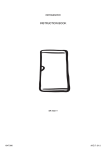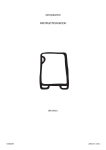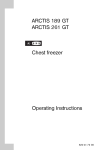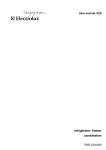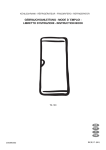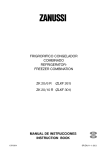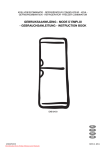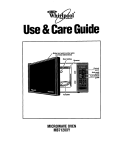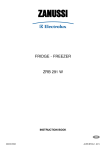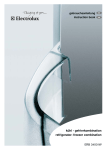Download Electrolux CV 850 S/2 (TT 120 F) Technical data
Transcript
AL U N MA LET E T ES BOOK E V ER THIS S N CO KEEP Y LEA D AND REA MANUAL DE INSTRUCCIONES INSTRUCTION BOOK CV 850 S/2 (TT 120 F) CONGELADOR FREEZER 200364378 ES GB SP/C/32-2. (04.) GB Before installing and using the appliance read this user's instruction book carefully. It contains safety precautions, hints, information and ideas. If the refrigerator is used in compliance with the instructions written, it will operate properly and provide you with greatest satisfaction. The symbols below help you to find things more easily: Safety precautions Warnings and information at this symbol serve safety for you and your appliance. Hints, useful information Environmental information Symbol for ideas At this symbol ideas can be found according to food and its storing. From the Electrolux Group. The worlds No.1 choice. The Electrolux Group is the world's largest producer of powered appliances for kitchen, cleaning and outdoor use. More than 55 million Electrolux Group products (such as refrigerators, cookers, washing machines, vacuum cleaners, chain saws and lawn mowers) are sold each year to a value of approx. USD 14 billion in more than 150 countries around the world. 15 GB Cont ents Important safety information...................................................................................................17 General safety precautions ....................................................................................................17 Precautions for child safety ....................................................................................................17 Safety precautions for installation............................................................................................17 Instruction for the User...........................................................................................................18 General information ..............................................................................................................18 Description of the appliance, main parts ..................................................................................18 Switch and indicator unit ...................................................................................................19 Handling the appliance .........................................................................................................19 Putting it into use .............................................................................................................19 Controlling the temperature ...............................................................................................19 Freezing.........................................................................................................................20 Storing...........................................................................................................................20 How to make ice cubes ....................................................................................................21 Some useful information and advice ........................................................................................21 Hints and ideas....................................................................................................................21 How to save energy .........................................................................................................21 The appliance and environment..........................................................................................21 Maintenance .......................................................................................................................21 Defrosting.......................................................................................................................21 Regular cleaning .............................................................................................................22 When the refrigerator is not in use......................................................................................23 Trouble shooting ..................................................................................................................23 Instructions for the Installer ....................................................................................................24 Technical data .....................................................................................................................24 Installing the appliance..........................................................................................................24 Transportation, unpacking .................................................................................................24 Cleaning.........................................................................................................................24 Placement ......................................................................................................................24 Change of door opening direction ......................................................................................25 Electrical connection........................................................................................................26 Storage time chart ................................................................................................................27 Warranty and service..............................................................................................................27 Guarantee conditions ...........................................................................................................27 Service and spare parts ........................................................................................................27 16 GB Im por t ant saf e t y inf or mation General safety precautions Keep these instructions and they should remain at the appliance when moving away or changing owner. This appliance is designed for storing and freezing food, domestic use according to these instructions only. Specialised companies that are qualified to do so by the manufacturer must carry out service and repairs including repairing and changing the power cord. Accessory parts supplied by them should be used only for repairing. Otherwise the appliance can be damaged or can cause other damage or injury. The appliance is out of circuit only in that case if the plug is removed from the socket. Before cleaning and maintenance always unplug it (do not get it by the cable). If the socket is difficult to reach, switch off the appliance by cutting off the current. Power cord must not be lengthened. Make sure that the power plug is not squashed or damaged by the back of the fridge/freezer. - A damaged power plug may overheat and cause a fire. Do not place heavy articles or the fridge/freezer itself on the power cord. - There is a risk of a short circuit and fire. Do not remove the power cord by pulling on its lead, particularly when the fridge/freezer is being pulled out of its niche. - Damage to the cord may cause a short-circuit, fire and/or electric shock. - If the power cord is damaged, it must be replaced by a certified service agent or qualified service personnel. If the power plug socket is loose, do not insert the power plug. - There is a risk of electric shock or fire. When cleaning, defrosting, taking out frozen food or ice tray do not use sharp, pointed or hard devices, as they can cause damage to the appliance. Be careful not to allow liquids to the temperature control, switch gear and indicator respectively. Ice and ice-cream can cause hurt if they are eaten immediately after removal from the frozen food compartment. After dissolving frozen food must not be refrozen, it must be used up as soon as possible. Store pre-packed frozen food in accordance with the frozen food manufacturer's instructions. You must not make defrosting faster with any electric heating appliance or chemicals. Do not make hot pot touch the plastic parts of the freezer. Do not store flammable gas and liquid in the appliance because they may explode. Do not put carbonated drinks, bottled drinks and bottled fruits into the freezer. Precautions for child safety Do not allow children to play with the packaging of the appliance. Plastic foil can cause suffocation. Adults must handle the appliance. Do not allow children to play with it or its controlling parts. If you are discarding the appliance pull the plug out of the socket, cut the connection cable (as close to the appliance as you can) and remove the door to prevent playing children to suffer electric shock or to close themselves into it. Safety precautions installation for Put the appliance to the wall to avoid touching or catching warm parts (compressor, condenser) to prevent possible burn. When moving the appliance take care of the plug not to be in the socket. When placing the appliance take care not to stand it on the power cord. <None>Adequate air circulation should be around the appliance, lacking this leads to overheating. To achieve sufficient ventilation follow the instructions relevant to installation. For the safety of life and property keep the precautions of these user's instructions as the manufacturer is not responsible for damages caused by omission. 17 GB Ins tr uctions f or the User General information The official designation of the appliance is home freezer. According to this the appliance is suitable for storing frozen and deep-frozen food, freezing products in quantity given in the user's instructions at home and making ice. The appliance can meet the requirements of standards between different temperature limits according to the climate class. The letter symbol for climate class can be found on the data plate. Description of the appliance, main parts 9 5 10 1 8 2 11 3 12 4 6 13 7 1. Freezing tray 6. Defrost water outlet 2. Freezing compartment (with ice tray) 7. Adjustable feet 3. Storing compartments (wire baskets) 8. Door gasket 4. Data plate 9. Thermostat 5. Switch and indicator unit: 10. Air grid a) Green lamp 11. Condenser b) Red lamp 12. Air flow c) Yellow lamp 13. Compressor d) Continuous-operation (fast freezer) switch e) Thermostat knob In figures the T T 120 F appliance can be seen. 18 GB Switch and indicator unit See chapters Putting it into use, Controlling the temperature and Freezing how to use the switch gear and indicator. Its parts: a). Green lamp This lamp gives light when the appliance is live i. e. the mains plug is in the mains socket. b). Red lamp This lamp switches on depending on the temperature inside the appliance. It gives light for a short time when starting the appliance, placing fresh food into it and when the thermostatic control knob has been turned in direction of lower temperature. It gives light permanently when the temperature inside the appliance is too high (overloaded with warm food, door stayed open or the gasket does not close properly) or possibly the appliance has gone wrong. c). Yellow lamp It gives light when the continuous-duty operation switch is on. d). Continuous operation (fast freezer) switch When the switch is in right-hand position the compressor operates continuously and provides the available coldest inside temperature that is necessary for freezing this way. e). Thermostat knob This is for setting and changing the temperature inside the appliance. Handling the appliance Putting it into use Put the plug into the mains socket. Turn the thermostatic control knob according to the figure. This time the red lamp starts giving light, the compressor starts and cooling begins shortly. When the red light goes out the temperature is sufficient and the appliance is suitable for storing frozen and deep-frozen foods. Controlling the temperature The thermostatic controller interrupts the operation of the appliance automatically for more or less time depending on the setting then restarts it assuring the required temperature. 19 GB Setting the thermostat knob can be done practically with a coin. Turning the control knob clockwise cooling becomes more and more intensive. In the appliance -18 °C or lower temperature can be reached if the thermostat knob is set according to the figure. The thermostat can be switched off (0 position), which means breaking the circuit of the compressor i.e. stopping cooling. The temperature coming about in the freezer is effected by not only the position of the thermostatic control and the ambient temperature, but frequency of door openings and the quantity of food put into it, etc. In maximum position of the thermostat - in case of increased demand e.g. during heatwaves the compressor may operate continually. This does not cause damages to the appliance. Freezing Freezing different products should always be done in the freezing compartment after proper preparing. Move the fast freezer switch to the right (yellow lamp gives light) 4 hours before freezing food in small quantity and about 24 hours before in case of products in bigger quantity. This time the compressor operates continually to reach the temperature necessary for freezing. Place the foods to be frozen in and operate the appliance as written for about 24 hours. After these move the fast freezer switch to the left (yellow light will go out). The freezing tray is suitable for freezing smaller fruits (raspberry, strawberry, currant, etc.). Fruits should be put in the tray in thin layers without packaging. After freezing they can be packed and sorted out then placed into the storing compartments. Storing It is practical to replace frozen products into the storing compartments (cages) after freezing has finished so that to make room in the freezing compartment for another freezing. Intermediate freezing does not deteriorate foods already stored. 20 GB How to make ice cubes To make ice cubes fill the enclosed ice cube tray with water and put it to the frozen food compartment. Wetting the bottom of the tray and setting thermostatic control knob to maximum stage can shorten preparing time. After finishing do not forget to reset the thermostatic control to the suitable stage. Ready ice cubes can be taken out of the tray under running water then twist or hit it. Some useful information and advice After opening and closing the door of freezer vacuum will rise inside the appliance because of the low temperature. So wait 2-3 minutes after closing the door - if you want to open it again - while inner pressure equalises. Take care of operating the freezer at a position of thermostatic control so that the inside temperature can never go beyond -18 °C, since temperature higher than this can deteriorate frozen foods. It is practical to make sure of faultless operation of the appliance daily so as to notice possible failure in time and prevent deterioration of frozen foods. The appliance and environment This appliance does not contain gasses which could damage the ozone layer, in either its refrigerant circuit or insulation materials. The appliance shall not be discarded together with the urban refuse and rubbish. Avoid damaging the cooling unit, especially at the rear near the heat exchanger. Information on your local disposal sites may be obtained from your municipal authorities. The materials used on this appliance marked with the sympol are recyclable. Maintenance Defrosting Bleeding part of the moisture of cooling chamber in form of frost and ice goes with the operation of the appliance. Thick frost and ice has an insulating effect, so it reduces cooling efficiency as the temperature increases, it needs more energy, at a certain thickness it does not allow the door of the freezing compartment to open, possibly the door can be broken. Hints and ideas In this chapter practical hints and ideas are given about how to use the appliance to reach maximum energy saving and there is environmental information about the appliance as well. How to save energy Avoid putting the appliance in a sunny place and near anything that gives off heat. Be sure that the condenser and the compressor are well ventilated. Do not cover the sections where ventilation is. Wrap products in tightly closing dishes or cling film to avoid building up unnecessary frost. Avoid products put in the freezer compartment to touch foods already frozen. Do not leave the door open longer than necessary and avoid unnecessary openings. Put warm foods into the appliance only when they are at room temperature. The condenser must be kept clean. 21 GB It is possible to scrape off and remove smaller frost and ice with the enclosed ice scraper. The tray in figure is not a piece of accessories to the appliance! When ice coating is so thick that it can not be removed with the frost scraper defrosting is necessary. Its frequency depends on usage. How to defrost it: Break the circuit of the appliance. Take the frozen foods out of the appliance and put them into a basket lined with paper or cloth. Store them in a possibly cool place or replace them into a frozen or fresh food compartment of a refrigerator. Leave the door open. Sweep off the melting water occasionally with a cloth or sponge in direction of sides which gathers in the outlet channel practically formed in the bottom of the appliance and can be removed as follows: Put an tray high enough in front of the appliance. Pull out defrost water outlet placed in the middle of the bottom of the appliance carefully in the direction of the arrow. Defrost water will flow into the tray through the outlet. Defrosting process can be made quicker by placing a pot or dish filled with warm water to the cooling plate formed as a shelf. After defrosting wipe the surfaces and push defrost water outlet back. Apply voltage to the appliance. After the red light has gone out put the foods back. Regular cleaning It is practical to clean the inside of the freezer and defrost it at a time. Household cleaner or soap must not be used. After breaking the circuit wash the appliance using lukewarm water and wipe it. Clean the door gasket with clean water. After cleaning apply voltage to the appliance. It is recommended to remove the dust and dirt collected on the back of the appliance and the condenser once or twice a year. 22 GB When the refrigerator is not in use In case the appliance will not be used for a long time follow these steps: Remove plug from the mains socket. Remove foods from the refrigerator. Defrost and clean it as written before. Leave the door open to avoid a build up of air inside. Trouble shooting During operation of the appliance some smaller but annoying trouble can often occur, which does not require calling a technician out. In the following chart information is given about them to avoid unnecessary charges on service. We draw your attention that operation of appliance goes with certain sounds (compressor- and circulating sound). This is not trouble, but means normal operation. We draw it to your attention again that the appliance operates discontinuously, so the stopping of compressor does not mean being nocurrent. That is why you must not touch the electrical parts of the appliance before removing it from the mains socket. Problem The appliance does not cool sufficiently The appliance cools too hard The appliance does not cool at all The appliance is noisy Possible cause Thermostatic control is set too low. Before freezing the appliance was not precooled sufficiently. Large-sized food was put in. Too many foods to be frozen were put in. Warm foods were put in. Door is not shut properly. The thermostatic control is set too high. Solution Set higher position. Pre-cool the appliance for enough time. Cut up food. Put fewer foods to be cooled. Put foods max. at room temperature. Check if the door is shut. Set lower position. Plug is not connected to the mains socket Check if the connection is proper. properly. Check if there is voltage. There is no voltage in the mains socket. Check setting of thermostatic control. Thermostatic control is in 0 position. Check if the appliance stands stable (all the four The appliance is not supported properly. feet should be on the floor). Inasmuch as the advice does not lead to result, call the nearest brand-mark service. 23 GB Ins tr uctions f or the Ins t aller Technical data Model/Type Gross capacity (l) Net capacity (l) Width (mm) Height (mm) Depth (mm) Energy consumption (kWh/day) (kWh/year) Energy class, according to EU Standards Freezing capacity (kg/24h) Rising time (h) Rated power (W) Weight (kg) CV 850 S/2 (TT 120 F) 117 100 550 850 600 0.90 329 C 16 17 120 39 Installing the appliance Transportation, unpacking It is recommended to deliver the appliance in original packaging, in vertical position considering the protective warning on packaging. After each transportation the appliance must not be switched on for approx. 2 hours. Unpack the appliance and check if there are damages on it. Report possible damages immediately to the place you bought it. In that case retain packaging. Cleaning Remove every adhesive tape, which ensure the parts not to move in the appliance. Wash the inside of the appliance using lukewarm water and mild detergent. Use soft cloth. After cleaning wipe out the inside of the appliance. Placement The ambient temperature has an effect on the energy consumption and proper operation of the appliance. When placing, take into consideration that it is practical to operate the appliance between ambient temperature limits according to the climate class that is given in the chart below and can be found in the data label. Class of climate Ambient temperature SN +10 ... +32 °C N +16 ... +32 °C ST +18 ... + 38 °C If the ambient temperature goes below the lower data the temperature of the cooling compartment can go beyond the prescribed temperature. If the ambient temperature goes beyond the upper data this means longer operating time of the compressor, increasing temperature in the freezer or increasing energy consumption. 24 GB When placing the appliance ensure that it stands level. This can be achieved by two adjustable feet (1) at the bottom in front. 1-1 piece of distance washers (2) are accessories of the adjustable feet. If levelling the appliance requires, these washers can be removed. Do not stand the appliance on a sunny place or close to a radiator or cooker. If it is unavoidable because of furnishing and the appliance has to be stood near a cooker take these minimum distances into consideration: 2 1 In case of gas or electric cooker 3 cm must be left, when it is less put a 0,5 - 1 cm non-flam insulation between the two appliances. In case of oil or coal-fired stove the distance must be 30 cm since they give off more heat. The refrigerator is designed to operate when it is totally pushed to the wall. When placing the refrigerator keep minimal distances recommended in figure. A: placing it under a wall-cupboard B: placing it freely Change of door opening direction Should the setting-up place or handling demand it, door-opening direction can be refitted from righthanded to left-handed. Following operations are to be done on the basis of figures and explanations: Break the circuit of the appliance. Tilt back the appliance carefully being careful so that the compressor can not touch the floor. It is recommended to ask another person for help, who can keep the appliance at this position safely. Unscrew the adjustable feet situated on both sides (2 pieces), in addition the screws fixing the lower door holders (3 pieces) and the screw on the other side respectively. Put over the pin in the lower door holding plate in the direction of the arrow. Take the door off. 25 GB Unscrew the top door holding pin and put it on the other side. Fit the door to the top door holding pin. Fix the bottom door holders on the other side being careful that the edge of the door is parallel with the side of cupboard. Then screw in the one screw in the place set free on the other side as well as the adjustable feet (2 pieces) and set up the box. Put over the handle and the plastic nails on the other side. Put the appliance to its place, set it level and apply voltage to it. In case you do not want to perform the procedures above, call the nearest brand-mark service. Technicians will accomplish the refitting expertly for charge. Electrical connection This refrigerator is designed to operate on a 230 V AC (~) 50 Hz supply. The plug must be put into a socket with protective contact. If there is no such, it is recommended to get an electrician to fit an earthed socket in compliance with standards near the refrigerator. This appliance complies with the following E.E.C. Directives: 73/23 EEC of 19.02.73 (Low Voltage Directive) and subsequent modifications, 89/336 EEC Compatibility modifications. 26 of 03.05.89 (Electromagnetic Directive) and subsequent GB S t or age time char t Storage time of deep-frozen and frozen products Foods In the fresh food compartment +2 - +7°C In the **** frozen food compartment -18°C 1 day 12 months 1 day 12 months 1 day 6 months 1 day 12 months 1 day 6 months 1 day 12 months 1 day 1 day 1 day 5 months 6 months 3 weeks Vegetables: green beans, green peas, mixed vegetables, marrow, corn, etc. Ready-cooked foods: vegetable dish, trimmings, with meat, etc. Ready-cooked foods: sirloin steaks, stew from knuckle of ham, meat from pig pudding, etc. Foods from potatoes, pasta: mashed potato, gnocchi, dumpling, pasta filled with jam, chips Soups: meat-broth, soup from green beans, soup from green peas, etc. Fruits: sour cherry, cherry, gooseberry, fruit cream, mashed maroon Meat: chicken, duck, goose fillets, tuna fish Popsicle, ice-cream War r ant y and ser vice Guarantee conditions Service and spare parts If calling the service is unavoidable, announce the trouble at a brand-mark service nearest to your place. When announcing the appliance has to be identified according to its data label. The data label of the appliance is stuck to the wall of the interior beside the vegetable box in the fresh food compartment in the bottom on the left side. All necessary data are there which are needed to the service announcement (type, model, serial number, etc.). Note here the data from the data label of your appliance: Model Product No. Serial No. Date of purchase: The manufacturer reserves the right to make any changes in the products. 27 MENDEZ ALVARO, 20 28045 MADRID 2004. 04. 06. The Electrolux Group is the world's largest producer of powered appliances for kifchen, cleaning and outdoor use. More than 55 million Electrolux Group products (such as refrigerations, cookers, washing machines, vaccum cleaners, chain saws and lawn mowers) are sold each year to a value of approx. USD 14 billion in more than 150 countries around the world. Printed by Xerox Hungary Ltd. From the Electrolux Group. The world's No.1 choice.















